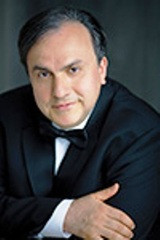|
Back
Dances and Thunder and Babes Torn Asunder New York
David Geffen Hall, Lincoln Center
02/18/2016 - & February 19*, 20, 23, 2016
Kodály Zoltán: Dances of Galánta
Liszt Ferenc: Piano Concerto No. 2 in A major
Antonín Dvorák: Vodník, Opus 107
Maurice Ravel: La Valse
Yefim Bronfman (Pianist)
New York Philharmonic, Juraj Valcuha (Conductor)

J. Valcuha (© Courtesy of the Artist)
”The chaos of the ‘A Major Piano Concerto’ sounds like it was drawn haphazard out of a musical kaleidoscope. Why was such trash allowed to figure in the program? Are soloists allowed to play whatever they choose?”
From the London Sporting News, 1875
Oh, the invective Ferenc Liszt suffered during his long prodigious lifetime. He must have cried all the way to the bedrooms of princesses, duchesses, infantas and celebs throughout the Continent. Not confined to a Weimar organ loft or a Viennese hovel, he happily stored his insults from the plebs, and roamed wherever the candelabras, Boesendorfers and grand royal invitations took him, giving concerts for swooning debutantes and fainting mondaines. And somehow–I’ve always wondered how–he continued to compose music over which naysayers twitch, over which master pianists revel.
We’ve had two of them this week, each playing one of his concertos. Thursday evening, while the New York Philharmonic was giving one of four Liszt concerts, Iván Fischer’s Budapest Festival Orchestra gave their only performance of Liszt’s First Concerto, this played by Marc-André Hamelin. Friday morning, a full house filled with appreciative New York youngsters, listened with surprising rapture to hear the Second Concerto, this essayed by Yefim Bronfman.
Both are great pianists. But their difference in handling Liszt was the difference between lightning and thunder.
Mr. Hamelin was the lightning. Not especially in speed, but in giving veneer, polish, artful, technically velvety rapidity to the E Flat Concerto. One felt a comfort, a veneration for his skill, his emotional embrace of the music.

Y. Bronfman (© Dario Acosta)
Yefim Bronfman, though, was the thunder. Not the thunder of an earthly artist, but the shaking Olympian thunder from on high. Gods don’t have to pound to show their power. A mere trill here, a simple arpeggio there, and the Steinway Grand shakes and the floor vibrates.
Mr. Bronfman doesn’t make things look easy. No, he won’t lean over the piano and grimace. Yet so assured is he, so lightly do his fingers roam over the keyboard, with such pent-up strength does he attack the superficially showy concerto that one knows that no mortal could handle such sounds.
A critic once called the A Major Concerto “The life and adventures of a melody.” Liszt could have created endless melodies, but for the concerto form he gave himself the challenge of unraveling as much as possible from that one melody.
With Yefim Bronfman, this was not difficult. He could be highly sensitive, almost quirky as he followed cellist Eric Bartlett. He could perform that march with stately stance, and continue with pianistic fury. And when he and the Phil reached the end, the artist turned the force of thunder into the finale of the elements.
Just because one expects nothing less from Mr. Bronfman doesn’t mean that such brilliance is expected. It is always–always–a gift from the gods.
I mentioned the school kids –but they should have been banned from listening to Antonín Dvorák’s innocently-titled “Water Goblin”. The music here, conducted with great spirit by Slovakian Juraj Valcuha, is unsuitable for children. Rape, drowning, torture, and finally a baby torn in two is not exactly a pleasant fairy tale. But Mr. Valcuha probably grew up with these morbid tales, and the composer offered as much scintillation and major-minor changes to keep us like children waiting for the great string sounds as the baby is torn in half.
Two dance pieces bookended this amorphous but enchanting program. Zoltán Kodály’s Galánta Dances, the second Hungarian work, began with trepidation, but once clarinetist Anthony McGill took over the Romany/Klezmer solos, the dances rollicked along. La Valse rarely fails, and the conductor, with no exaggeration or rubato, propelled the Ravel to its stunning finish.
Harry Rolnick
|